HP at CES 2019: HP Spectre x360 15 Gets AMOLED Display
by Anton Shilov on January 6, 2019 12:02 PM EST- Posted in
- Notebooks
- HP
- Laptops
- AMOLED
- Spectre
- Trade Shows
- OLED
- CES 2019
- Spectre x360
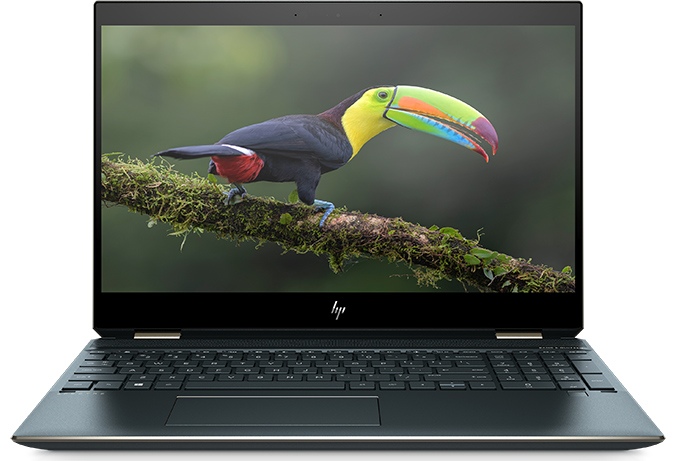
HP plans to release a revamped version of its current-generation Spectre x360 15 convertible laptop with a 15.6-inch AMOLED display this year, the company has revealed ahead of CES. The inclusion of an OLED display makes this a very notable occurrence, as the the laptop will be the latest and largest of a small handful of devices released over the past few years to get such a display.
It goes without saying that the display is among the key hardware components in any laptop, and plays a significant part in determining the overall experience with the device. By using an AMOLED panel instead of a traditional high-quality IPS-based one, HP's top-of-the-range Spectre x360 15 will be able to offer very bright and accurate colors (covers 100% of the DCI-P3 color space), a very high contrast ratio (100,000:1), wide horizontal viewing angles, deep blacks, fast response time (think 0.1 ms) as well as everything good that the AMOLED technology is known for. The catch, of course, is that OLED traditionally comes with some downsides as well (e.g., off-axis color shifting, ghosting, burn-in, etc.), but it remains to be seen how this will play out for the Spectre x360 15.
HP says that the display will support HDR, but does not specify whether it means HDR10 or Dolby Vision spec. The company also isn't disclosing the resolution of the screen it plans to use, so it remains to be seen whether it has managed to procure an Ultra-HD (3840×2160) panel, had to stick to a QHD (2560×1440) one, or used something more custom. The only thing we do know is that the laptop with an AMOLED monitor has the same bezels as the machine with an IPS LCD, which is logical as both screens feature the same 15.6-inch diagonal size (see photos of AMOLED and IPS versions below).
Featuring an ultra-thin chassis with golden accents and powered by Intel’s quad-core Whiske Lake-U processors as well as NVIDIA’s discrete GeForce GTX GPUs, current-gen HP’s Spectre x360 15 convertible laptops are already ranked among the top-performing thin-and-light 15.6-inch notebooks. By adding an AMOLED screen to the stylish enclosure with high-performance components, HP makes its flagship 15.6-inch laptop somewhat more impressive, but only a practical analysis of the product will reveal how good (or bad) HP's AMOLED display actually is.
HP plans to start selling its AMOLED display-equipped Spectre x360 15 this March. The company says that it will disclose exact specifications and prices closer to the actual launch, but it is reasonable to expect that AMOLED-equipped SKUs will come at a premium, and will likely be exclusively paired with other high-end components (CPU, GPU, SSD, Wi-Fi) to match.
HP is not the first company to use an OLED-type screen with mobile PCs. Lenovo launched ThinkPad X1 Yoga with an OLED monitor three years ago and we reviewed one back then. We did notice off-axis color shifting and ghosting on that display and Lenovo has not offered OLED-based mobile PCs since then. Obviously, technologies always evolve, so it will be interesting to see if and how HP's 15.6-inch AMOLED display has improved on matters since then.
Related Reading:
- HP Launches Ultra-Thin HP Spectre 13 x360: Quad-Core i7, Gigabit LTE, 22.5 Hr Battery Life
- HP at CES 2018: HP Spectre x360 using Intel with Radeon RX Vega M, $1370
- HP Unveils Spectre: The World’s Thinnest Laptop
- The Lenovo ThinkPad X1 Yoga Review: OLED and LCD Tested
Source: HP


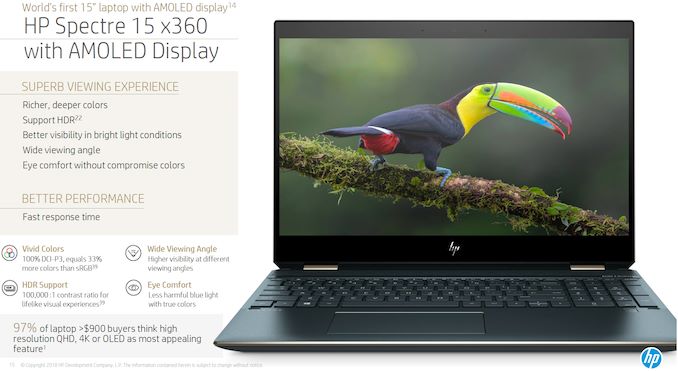
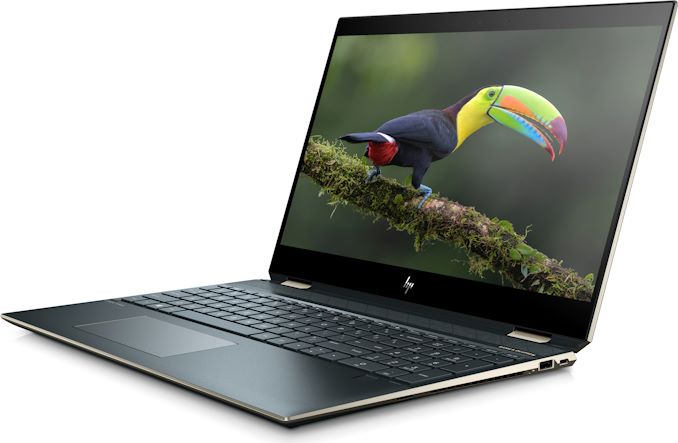
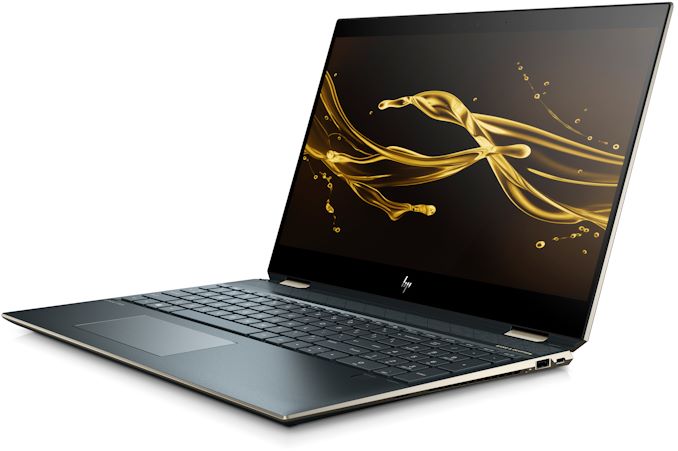
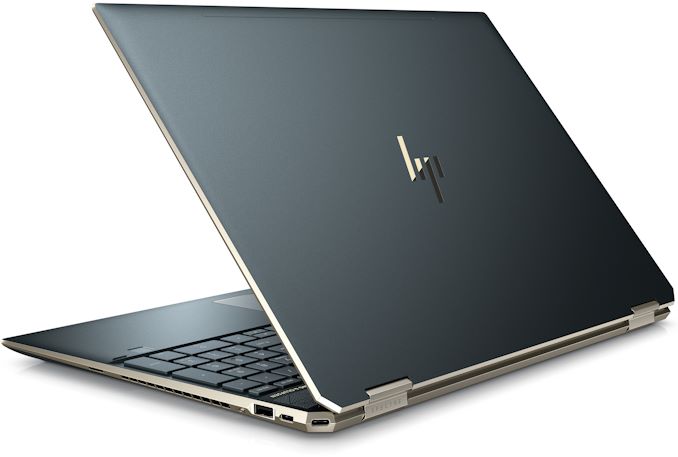








9 Comments
View All Comments
Diogene7 - Sunday, January 6, 2019 - link
I am very excited to the idea of finally seeing coming to the market (premium) laptop coming with OLED display !!!The color and black on OLED display looks so much better than LCD !!!
Really looking forward to see OLED rolling out in more laptop displays in 2019 / 2020 !!!
SirPerro - Sunday, January 6, 2019 - link
Why is "ghosting" listed as a downside? OLED screens are vastly superior in that regard and all the ghosting is just caused by the perception of the sample and hold mechanism used in the display.Thing is usually laptop displays don't strobe either to avoid eye strain and flicker, causing the same sample and hold perception ghosting (On top of the ACTUAL pixel decay ghosting) so I don't really understand the comment.
darkswordsman17 - Sunday, January 6, 2019 - link
Right, its because people perceive the sample and hold as ghosting/blur. For some its more apparent on OLED panels (while on normal LCDs I think the normal ghosting is dominant).hanselltc - Sunday, January 6, 2019 - link
I wish this thing has adaptive sync. This boi gonna be an impressive mobile gaming beast just for that display alone.Magichands8 - Sunday, January 6, 2019 - link
This, I'm sure, will be fantastic right up until you start noticing the screen burn-in and residual color tinting on the after the first few months. Then you'll realize you paid over $1,000 to be a guinea pig testing a half-baked technology that just isn't ready for prime time.Flying Aardvark - Monday, January 7, 2019 - link
Over $1000??? So basically, no money at all. Time to head back to school if you're short on a whole grand.darkswordsman17 - Sunday, January 6, 2019 - link
Er, I don't think this is the first time HP has used an AMOLED panel. I'm almost certain that one of the Spectre 2 in 1s (believe it was the 13) had one before, but it was very limited for some reason. I recall pricing it out and comparing it to the Lenovo Yoga. But not long after that, I checked and it was no longer an option, so maybe it wasn't actually sold or recalled?Which Samsung also had an AMOLED laptop/tablet/2n1, and they too pretty quickly ditched it, but I believe it was the first one and got reviewed by several places. They "updated" it with an LCD. For some reason I'm thinking it had a 2160x1440 3:2 display though.
jaju123 - Monday, January 7, 2019 - link
Any ideal from where this panel is being sourced? Is it LG, BOE, Samsung? Any idea?Prestissimo - Tuesday, January 8, 2019 - link
Spectre x360 15 has been shipping with i7-8750H and 4GB 1050 Ti Max-Q since October 2018.Now they're suddenly switching back to U-CPU?